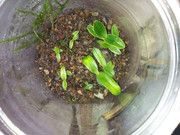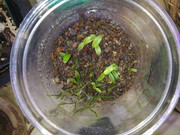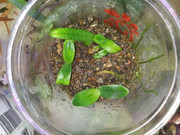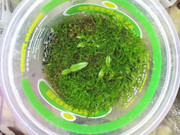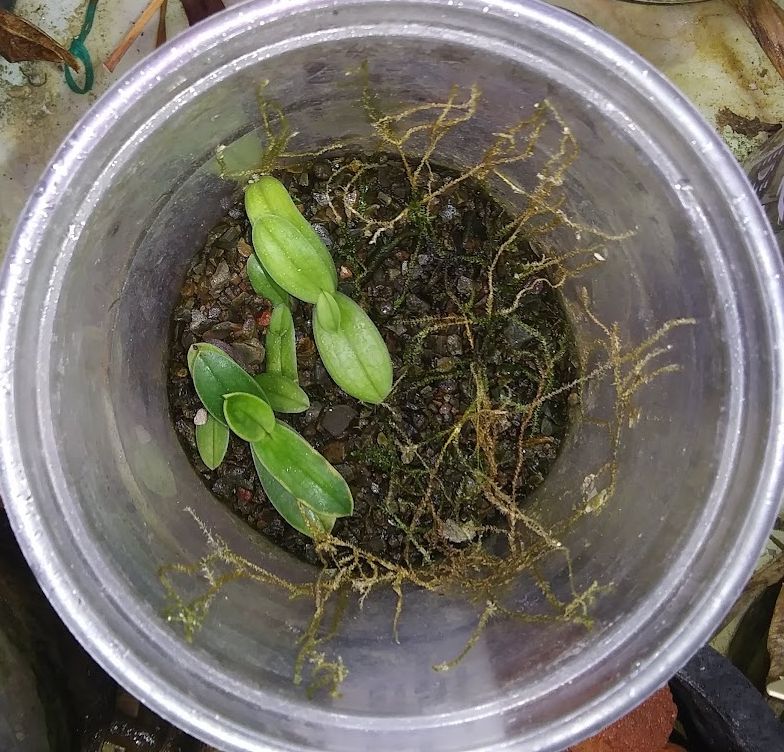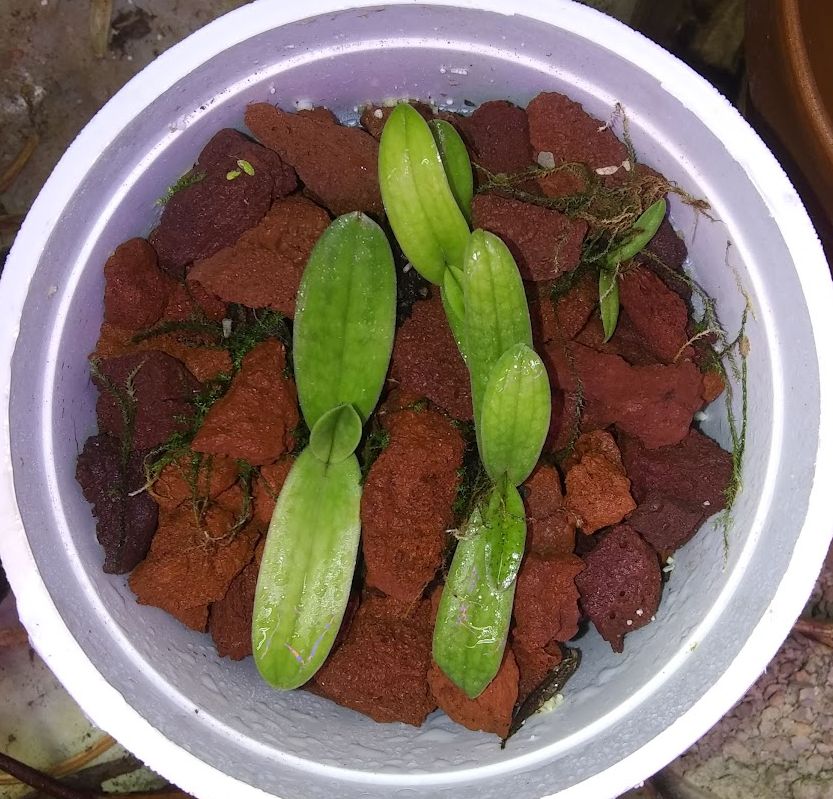Hello,
So, a journey of a new cross begins.
Last year Duck Slipper gave me some pollen of his Paph. concolor ‘Yellow Bird’ x thaianum ‘Perfecto’ to put on my InCharm Topaz (Lisa x Davelle) :
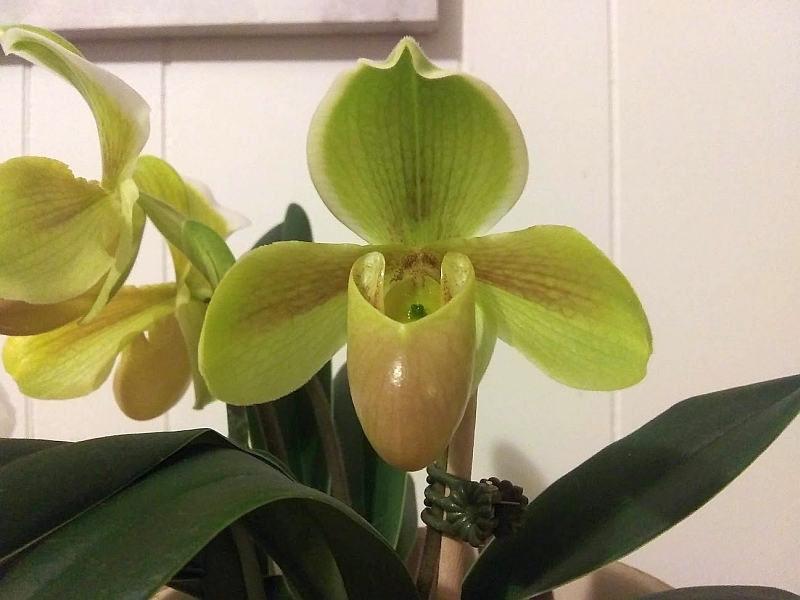
The pod matured and the seed sown (B138 terrestrial orchid medium from ajorchids on Ebay) but germination wasn't all that fantastic. The protocorms were replated on O156 replate medium (from ajorchids) and they grew to the point where I could give Duck Slipper some flasks and deflask the seedlings.
One flask got contaminated early on and was deflasked in desperation:

Inspired by Ray's semi-hydroponics I opted to deflask into what I had on hand: Safe-T Sorb (which I used as substrate in my aquaria). This is calcined clay granules with some iron and other mineral content. The plants above were deflasked some months back and now that the weather is warming they are putting out new leaves and growing nicely. The smaller group of plants weren't much more than protocorms at the time. I would wet the Safe-T Sorb with K-lite solution and then stand it in a shallow dish so there is always water being wicked up like in semi-hydroponics. The cup is covered with some plastic with small vents to maintain humidity. This has worked very well. The large clump to the left is from the plants I deflasked this week. There was considerable protocorm multiplication with the medium I used. Hopefully these clumps are super-looking clones.
These were deflasked a 2 days ago:

The larger seedlings show a nice mottled pattern. One of the smaller seedlings shows some sign of variegation but time will tell. Some of the the plants weren't much more than protocorms and it will be interesting to see if they take or if I just got lucky last time. Seedlings got a spraying with 3% H2O2 after being potted which is why they look wet.
The earlier deflasked plants now get K-lite watered from above but these newer ones will get some dilute K-lite from the bottom up for a while with overhead misting with RO to dilute salts a bit. So far there is no sign of salt creep in the first deflasked batch.
I will need to find a source of crushed brick for up-potting. Back in SA my complex Paphs and thaianum grew great in crushed brick with daily watering. I would add some leaf litter in with the complex plants.
I hope fortune smiles on me and I can continue updating this thread with photos of growing plants and, eventually, the first flowers. This is something of an experiment with the Safe-T Sorb.
Happy weekend
So, a journey of a new cross begins.
Last year Duck Slipper gave me some pollen of his Paph. concolor ‘Yellow Bird’ x thaianum ‘Perfecto’ to put on my InCharm Topaz (Lisa x Davelle) :

The pod matured and the seed sown (B138 terrestrial orchid medium from ajorchids on Ebay) but germination wasn't all that fantastic. The protocorms were replated on O156 replate medium (from ajorchids) and they grew to the point where I could give Duck Slipper some flasks and deflask the seedlings.
One flask got contaminated early on and was deflasked in desperation:

Inspired by Ray's semi-hydroponics I opted to deflask into what I had on hand: Safe-T Sorb (which I used as substrate in my aquaria). This is calcined clay granules with some iron and other mineral content. The plants above were deflasked some months back and now that the weather is warming they are putting out new leaves and growing nicely. The smaller group of plants weren't much more than protocorms at the time. I would wet the Safe-T Sorb with K-lite solution and then stand it in a shallow dish so there is always water being wicked up like in semi-hydroponics. The cup is covered with some plastic with small vents to maintain humidity. This has worked very well. The large clump to the left is from the plants I deflasked this week. There was considerable protocorm multiplication with the medium I used. Hopefully these clumps are super-looking clones.
These were deflasked a 2 days ago:

The larger seedlings show a nice mottled pattern. One of the smaller seedlings shows some sign of variegation but time will tell. Some of the the plants weren't much more than protocorms and it will be interesting to see if they take or if I just got lucky last time. Seedlings got a spraying with 3% H2O2 after being potted which is why they look wet.
The earlier deflasked plants now get K-lite watered from above but these newer ones will get some dilute K-lite from the bottom up for a while with overhead misting with RO to dilute salts a bit. So far there is no sign of salt creep in the first deflasked batch.
I will need to find a source of crushed brick for up-potting. Back in SA my complex Paphs and thaianum grew great in crushed brick with daily watering. I would add some leaf litter in with the complex plants.
I hope fortune smiles on me and I can continue updating this thread with photos of growing plants and, eventually, the first flowers. This is something of an experiment with the Safe-T Sorb.
Happy weekend





